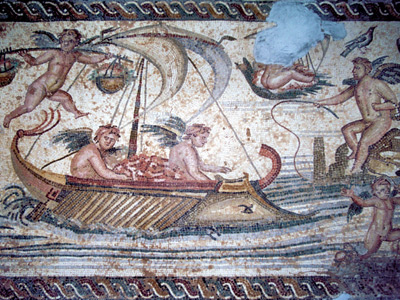
Ask the AI Tutor
Need help with Physics - Specific Heat Capacity (AQA)? Ask our AI Tutor!
AI Tutor - Lucy
Connecting with Tutor...
Please wait while we establish connection

The Romans had underfloor heating over 2,000 years ago.
Physics - Specific Heat Capacity (AQA)
Explore how heating curves link temperature, state changes and energy, and see how specific heat capacity explains why some materials warm up faster than others.
1 .
Substances with a low specific heat capacity can store how much thermal energy?
They can not store any thermal energy
They can store some thermal energy
They can store a lot of themal energy
They can store an unlimited amount of thermal energy
The greater the specific heat capacity, the greater the quantity of thermal energy the material can store
2 .
As well as the specific heat capacity, what else affects the amount of thermal energy a material can store?
Nothing - it's just the specific heat capacity that matters
The temperature change
The mass
Both temperature change and mass
Applying a higher temperature and using more of the material will increase the amount of thermal energy stored (and vice versa of course)
3 .
What symbol is used to represent the specific heat capacity of a material?
a
b
c
shc
c is also used to represent the speed of light
4 .
What are the units of specific heat capacity?
J/kgoC
JkgoC
J-1kg/oC
W/kg/oC
This needs to memorised for the exam
5 .
In a laboratory experiment, a group of students used a copper block with a hole drilled in for a thermometer and a second hole in for the heater. Which of the following is not required to calculate the specific heat capacity?
Joulemeter reading at the start and end
Time taken
Starting temperature
Mass in kg of the copper block
This question tests if you know that the equation for specific heat capacity is Energy = Mass x Specific heat capacity x Temperature change. There is no mention of time
6 .
The specific heat capacity of water is 4,200 J/kgoC. The specific heat capacity of mineral oil is 2,100 J/kgoC. Based on this information, which statement is correct?
Mineral oil would be of little use for storing heat
Water would be no use for storing heat
Kilogram for kilogram, mineral oil can absorb more thermal energy than water
Water can store more heat than the same mass of mineral oil
You should know from your studies that both water and mineral oil are used for storing heat (oil filled radiators and central heating systems), so the first two statements are incorrect. Water has a greater specific heat capacity than the mineral oil so that rules out the third answer
7 .
How much energy must be transferred to raise the temperature of 2 kg of water from 27oC to 40oC? Water has a heat capacity of 4,200 J/kgoC
109,200 kJ
10,920 kJ
1,092 kJ
109.2 kJ
Straighforward use of the specific heat capacity equation. The specific heat capacity is given in joules but the units of the answers are in kilojoules, so you needed to divide your answer by 1,000
8 .
A homeowner uses a wood burning stove to heat his house. The casing of the stove gets hot when the wood inside is burning and is made from 120 kg of cast iron. It took 3,276 kJ of energy to raise the temperature of the stove casing from 18oC to 70oC. What is the specific heat capacity of the cast iron in J/kgoC?
0.525
525
1.904
1,904
This is testing how well you understand units. The calculation using 3,276 kJ will give you the answer in kJ/kgoC but the question asks for the answer expressed in J/kgoC
9 .
When a particular car engine is working normally, 1.5 kg of coolant at a temperature of 114oC with a specific heat capacity of the of 3,800 J/kgoC passes through the radiator each second. If 91.2 kJ of energy is transferred to the surroundings, what is the temperature of the coolant leaving the radiator?
16oC
98oC
0.016oC
120oC
Four things here - did you pay attention to the units, did you rearrange the equation correctly and did you remember that the answer is the temperature difference and that the temperature will go down because a radiator is designed to get rid of heat from a coolant? Well done if you did!
10 .
A block of copper was heated from 18oC to 33oC using 35 thousand joules of energy. The specific heat capacity of copper is 385 J/kgoC. What was the mass of the block of copper?
6.06 kg
0.385 kg
385 kg
It can't be worked out without more information
Dividing the energy by the specific heat capacity multiplied by the temperature rise gives the answer
**Unlimited Quizzes Await You! 🚀**
Hey there, quiz champ! 🌟 You've already tackled today's free questions.
Ready for more?
Ready for more?
🔓 Unlock UNLIMITED Quizzes and challenge yourself every day. But that's
not all...
not all...
🔥 As a Subscriber you can join our thrilling "Daily Streak" against other
quizzers. Try to win a coveted spot on our Hall of Fame Page.
quizzers. Try to win a coveted spot on our Hall of Fame Page.
Don't miss out! Join us now and keep the fun rolling. 🎉
**Unlimited Quizzes Await You! 🚀**
Hey there, quiz champ! 🌟 You've already tackled today's free questions. Ready for more?
🔓 Unlock UNLIMITED Quizzes and challenge yourself every day. But that's not all...
🔥 As a Subscriber you can join our thrilling "Daily Streak" against other quizzers. Try to win a coveted spot on our Hall of Fame Page.
Don't miss out! Join us now and keep the fun rolling. 🎉






